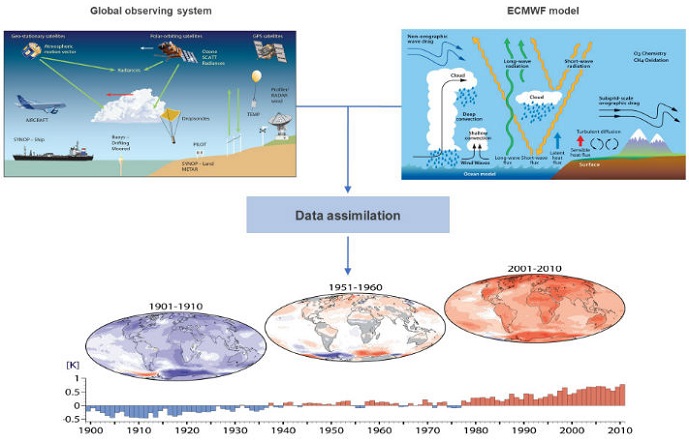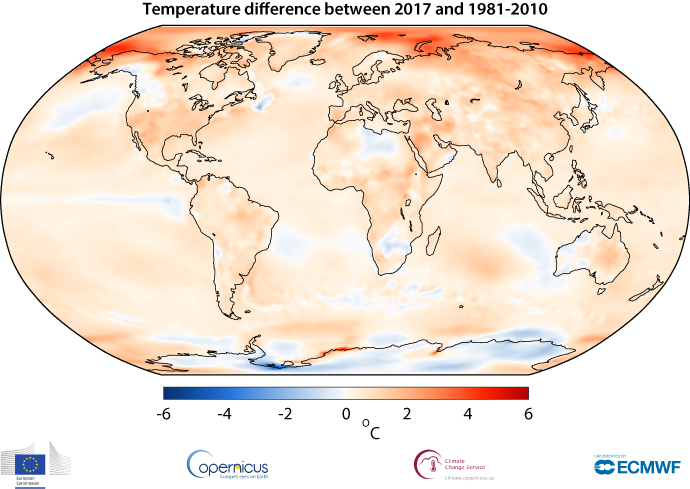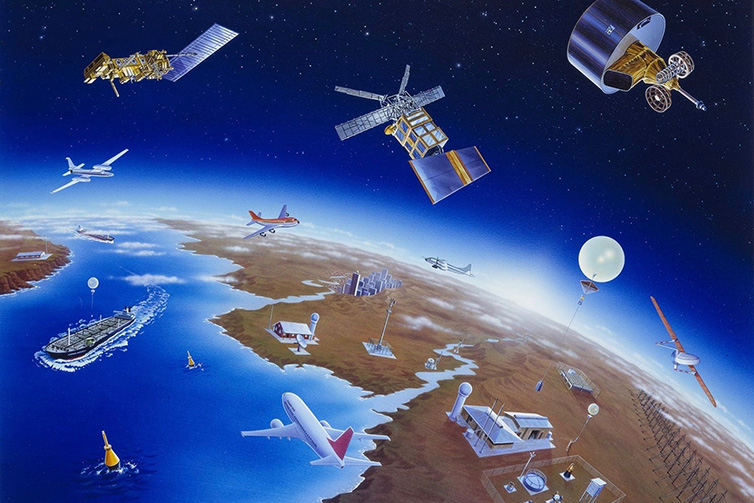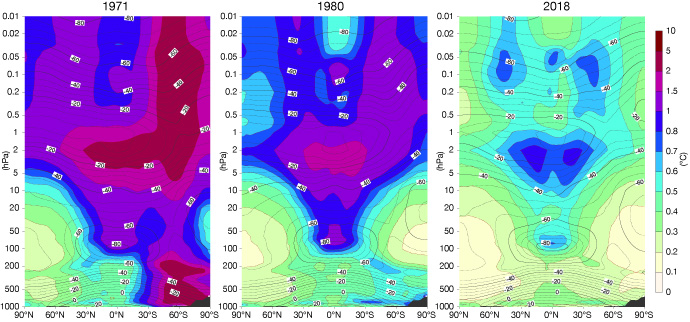

Hans Hersbach’s first post at ECMWF involved processing weather satellite data.
ECMWF’s new atmospheric reanalysis, ERA5, will soon provide a detailed picture of meteorological conditions back to 1979. Data from 2000 is already available and the remainder is due to be released in early January 2019.
ECMWF scientist Hans Hersbach has overseen the planning and production of this innovative dataset, which will eventually go back all the way to 1950.
Hans’s background in various aspects of using observations in numerical weather prediction equipped him with everything he needed.
After a PhD in theoretical physics, he obtained a position at the Dutch national meteorological service (KNMI) working on ocean waves and later ensemble forecasting. In 2000, he joined ECMWF to work on scatterometer satellite data. Scatterometers provide information on winds over the oceans by measuring the radar backscatter from waves.
“The scatterometer work gave me valuable experience in the processing of satellite observations, which is a key ingredient in reanalysis activities,” Hans says.
He went on to join ECMWF’s team working on the EU-funded, collaborative ERA-CLIM and ERA-CLIM2 reanalysis research projects. Three years ago, he became the leader of the Copernicus Climate Change Service (C3S) reanalysis team.
“The implementation of C3S by ECMWF on behalf of the EU has turned reanalysis from a research activity into a sustainable operational service,” Hans says.
“This has come with substantial new resources, which have enabled the development and production of ERA5.”

The ERA5 reanalysis provides a detailed picture of the track, intensity (contours, in hPa) and accumulated rainfall (shading, in mm) associated with Hurricane Florence as it struck the east coast of the US in September 2018 (left). Its predecessor, ERA-Interim, provides a less accurate and less detailed picture as it uses an older model version, fewer observations and a lower spatial and temporal resolution (right).
What is reanalysis and what is it for?
Atmospheric reanalysis combines a weather model with observations in a process called data assimilation. It creates a complete and consistent picture of meteorological conditions typically over several decades in the recent past.
“Past weather observations alone can never give us a full picture of what went on in the atmosphere, but reanalysis provides ‘maps without gaps’,” Hans quips.

Atmospheric reanalysis combines past weather observations from a range of sources with model information to provide a complete and consistent record of meteorological conditions.
Take any storm, heat wave or drought anywhere on the globe in recent decades: reanalysis provides us with the best possible idea of what exactly happened and how it came about.
“Reanalysis enables us to study in detail any past meteorological event. This makes it a valuable tool for scientists developing weather forecasting models, including at ECMWF,” Hans says.
Reanalysis can also be used to assess the improvement of forecasts at ECMWF over time. It provides a reference against which forecasts from successive model versions can be compared.
“Improvements relative to a reanalysis are real improvements: they are not just the result of atmospheric conditions, which sometimes happen to be more predictable,” Hans explains.
Other major areas of application include climate studies and climate change monitoring and assessment. For example, reanalysis data provided by C3S showed that 2017 was the third in a row of exceptionally warm years, while 2018 will likely be the fourth.

Air temperature at a height of two metres for 2017, shown relative to its 1981–2010 average, according to ERA-Interim reanalysis data. Monthly climate bulletins are published on the C3S website. Source: Copernicus Climate Change Service, ECMWF.
“ECMWF climate reanalysis is essential to the implementation of C3S,” Hans says.
He notes that ERA5 is by far the most popular dataset in the openly accessible C3S Climate Data Store.
“Reanalysis is now fully integrated into international assessments of climate change as delivered by, for example, the WMO, and in the European State of the Climate. What is more, ERA5 data are indispensable for many sectoral applications currently being developed by C3S.”
What’s new in ERA5?
Compared to ERA-Interim, ERA5 benefits from 10 years of improvements in the numerical weather prediction model and the data assimilation system used.
It also uses improved historical observations, boundary conditions for sea-surface temperature and sea ice, and external forcing, such as greenhouse gas concentrations, volcanic eruptions and changes in solar forcing.
ERA5 provides hourly information at a horizontal resolution of around 31 km globally and at 137 levels in the vertical, up from six-hourly fields at 79 km horizontal resolution and 60 levels in ERA-Interim.
It contains estimates of atmospheric variables such as air temperature, pressure and wind at different altitudes, as well as surface variables such as rainfall, soil moisture content and ocean wave height.

This animation shows the mean surface air temperature in Europe in January 2016 from ERA5 as it varies hour by hour.
Data challenges
The growing availability of satellite data, alongside conventional observations from e.g. weather balloons, weather stations, ships, buoys and aircraft, provides an opportunity for improving reanalyses. But it also presents some challenges.
“Carefully selecting suitable observational datasets and ensuring the quality of the data is an important part of any reanalysis project,” Hans says.
Even after production has started, Hans and his team need to carefully monitor the reanalysis data for any unexpected results.
“These could be a sign of an incorrect or inconsistent use of observational data. When necessary, we needed to rerun some parts of the reanalysis to rectify the error, prior to public release.”

Reanalysis uses observations from all available sources, but only after stringent quality checks. (Graphic: WMO)
How uncertain is the data?
Even with stringent data quality control and a high-performing model and data assimilation system, reanalysis data are associated with varying degrees of uncertainty.
The further back in time a reanalysis goes, the sparser weather observations become. What is more, all observations, weather models and data assimilation systems involve errors and approximations.
“Although the ERA5 dataset is one of most accurate sources of information on past meteorological conditions you can get, it is not 'the truth', and this is important for users to understand,” says Hans.
But ERA5 includes a novelty compared to ERA-Interim which allows users to assess the confidence they can have in the data.
“A key development in ERA5 is that it is an ensemble of 10 reanalyses. The spread between the 10 members reflects uncertainties in the model and the observations: a smaller spread means less uncertainty,” Hans explains.
The figure below illustrates how the spread, and thus the uncertainty, in ERA5 data has diminished as more and more observations have become available, including the early use of satellite data in 1980 and the full range of observations from the current observing system in 2018.

Three-monthly mean ensemble spread of temperature data across the atmosphere as a measure of uncertainty in the reanalysis. A higher spread as indicated by the shading means larger uncertainty.
Next steps
Continuous improvement of climate reanalysis (centennial, coupled, regional) features prominently in plans for the development of C3S.
The next step for ERA5 will be the production of data back to 1950, which will take about another year to complete. There are also plans for a coupled ocean/atmosphere reanalysis covering the 20th century and perhaps even the period to 1850. Beyond that, planning for a successor to ERA5, which will exploit the latest advances in Earth system modelling, is already under way.
